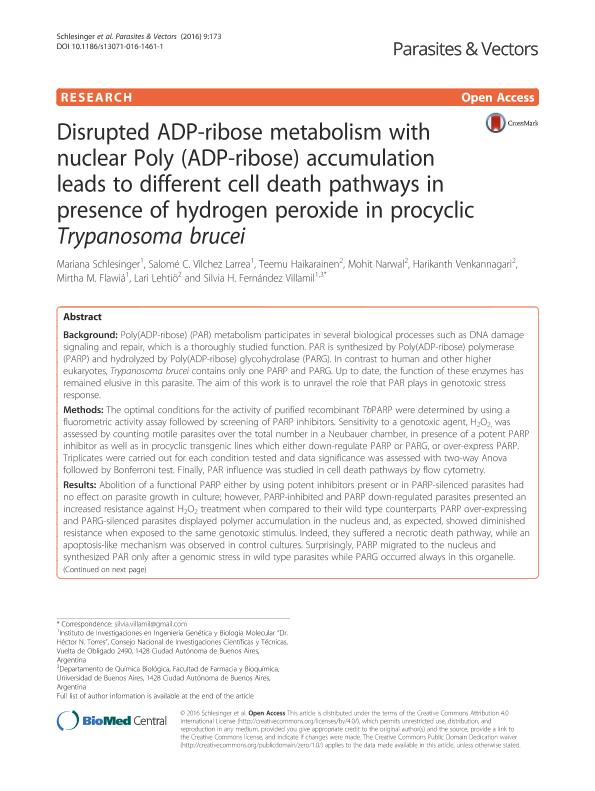Mostrar el registro sencillo del ítem
dc.contributor.author
Schlesinger, Mariana

dc.contributor.author
Vilchez Larrea, Salomé Catalina

dc.contributor.author
Haikarainen, Teemu
dc.contributor.author
Narwal, Mohit
dc.contributor.author
Venkannagari, Harikanth
dc.contributor.author
Flawia, Mirtha Maria

dc.contributor.author
Lehtiö, Lari
dc.contributor.author
Fernandez Villamil, Silvia Hebe

dc.date.available
2018-05-04T18:20:46Z
dc.date.issued
2016-03
dc.identifier.citation
Schlesinger, Mariana; Vilchez Larrea, Salomé Catalina; Haikarainen, Teemu; Narwal, Mohit; Venkannagari, Harikanth; et al.; Disrupted ADP-ribose metabolism with nuclear Poly (ADP-ribose) accumulation leads to different cell death pathways in presence of hydrogen peroxide in procyclic Trypanosoma brucei; BioMed Central; Parasites and Vectors; 9; 173; 3-2016; 1-15
dc.identifier.issn
1756-3305
dc.identifier.uri
http://hdl.handle.net/11336/44182
dc.description.abstract
Poly(ADP-ribose) (PAR) metabolism participates in several biological processes such as DNA damage signaling and repair, which is a thoroughly studied function. PAR is synthesized by Poly(ADP-ribose) polymerase (PARP) and hydrolyzed by Poly(ADP-ribose) glycohydrolase (PARG). In contrast to human and other higher eukaryotes, Trypanosoma brucei contains only one PARP and PARG. Up to date, the function of these enzymes has remained elusive in this parasite. The aim of this work is to unravel the role that PAR plays in genotoxic stress response.MethodsThe optimal conditions for the activity of purified recombinant TbPARP were determined by using a fluorometric activity assay followed by screening of PARP inhibitors. Sensitivity to a genotoxic agent, H2O2, was assessed by counting motile parasites over the total number in a Neubauer chamber, in presence of a potent PARP inhibitor as well as in procyclic transgenic lines which either down-regulate PARP or PARG, or over-express PARP. Triplicates were carried out for each condition tested and data significance was assessed with two-way Anova followed by Bonferroni test. Finally, PAR influence was studied in cell death pathways by flow cytometry.ResultsAbolition of a functional PARP either by using potent inhibitors present or in PARP-silenced parasites had no effect on parasite growth in culture; however, PARP-inhibited and PARP down-regulated parasites presented an increased resistance against H2O2 treatment when compared to their wild type counterparts. PARP over-expressing and PARG-silenced parasites displayed polymer accumulation in the nucleus and, as expected, showed diminished resistance when exposed to the same genotoxic stimulus. Indeed, they suffered a necrotic death pathway, while an apoptosis-like mechanism was observed in control cultures. Surprisingly, PARP migrated to the nucleus and synthesized PAR only after a genomic stress in wild type parasites while PARG occurred always in this organelle.ConclusionsPARP over-expressing and PARG-silenced cells presented PAR accumulation in the nucleus, even in absence of oxidative stress. Procyclic death pathway after genotoxic damage depends on basal nuclear PAR. This evidence demonstrates that the polymer may have a toxic action by itself since the consequences of an exacerbated PARP activity cannot fully explain the increment in sensitivity observed here. Moreover, the unusual localization of PARP and PARG would reveal a novel regulatory mechanism, making them invaluable model systems.
dc.format
application/pdf
dc.language.iso
eng
dc.publisher
BioMed Central

dc.rights
info:eu-repo/semantics/openAccess
dc.rights.uri
https://creativecommons.org/licenses/by-nc-sa/2.5/ar/
dc.subject
Trypanosoma Brucei
dc.subject
Par
dc.subject
Parp
dc.subject
Parg
dc.subject.classification
Otras Ciencias Biológicas

dc.subject.classification
Ciencias Biológicas

dc.subject.classification
CIENCIAS NATURALES Y EXACTAS

dc.title
Disrupted ADP-ribose metabolism with nuclear Poly (ADP-ribose) accumulation leads to different cell death pathways in presence of hydrogen peroxide in procyclic Trypanosoma brucei
dc.type
info:eu-repo/semantics/article
dc.type
info:ar-repo/semantics/artículo
dc.type
info:eu-repo/semantics/publishedVersion
dc.date.updated
2018-05-03T14:11:14Z
dc.journal.volume
9
dc.journal.number
173
dc.journal.pagination
1-15
dc.journal.pais
Reino Unido

dc.journal.ciudad
Londres
dc.description.fil
Fil: Schlesinger, Mariana. Consejo Nacional de Investigaciones Científicas y Técnicas. Instituto de Investigaciones en Ingeniería Genética y Biología Molecular ; Argentina
dc.description.fil
Fil: Vilchez Larrea, Salomé Catalina. Consejo Nacional de Investigaciones Científicas y Técnicas. Instituto de Investigaciones en Ingeniería Genética y Biología Molecular ; Argentina
dc.description.fil
Fil: Haikarainen, Teemu. University of Oulu; Finlandia
dc.description.fil
Fil: Narwal, Mohit. University of Oulu; Finlandia
dc.description.fil
Fil: Venkannagari, Harikanth. University of Oulu; Finlandia
dc.description.fil
Fil: Flawia, Mirtha Maria. Consejo Nacional de Investigaciones Científicas y Técnicas. Instituto de Investigaciones en Ingeniería Genética y Biología Molecular ; Argentina
dc.description.fil
Fil: Lehtiö, Lari. University of Oulu; Finlandia
dc.description.fil
Fil: Fernandez Villamil, Silvia Hebe. Consejo Nacional de Investigaciones Científicas y Técnicas. Instituto de Investigaciones en Ingeniería Genética y Biología Molecular ; Argentina
dc.journal.title
Parasites and Vectors

dc.relation.alternativeid
info:eu-repo/semantics/altIdentifier/url/http://parasitesandvectors.biomedcentral.com/articles/10.1186/s13071-016-1461-1
dc.relation.alternativeid
info:eu-repo/semantics/altIdentifier/doi/https://doi.org/10.1186/s13071-016-1461-1
Archivos asociados
